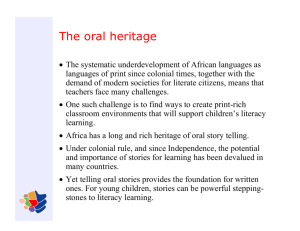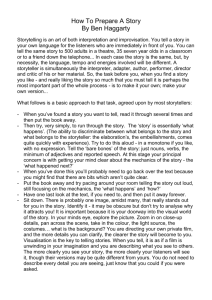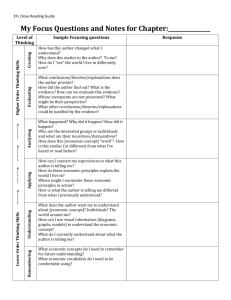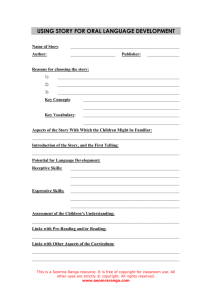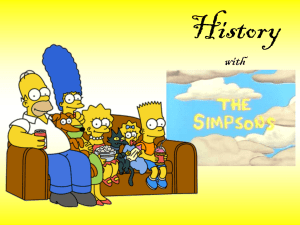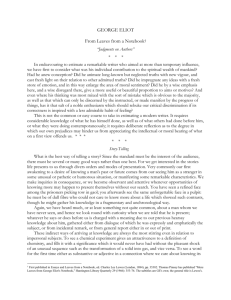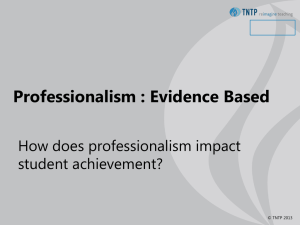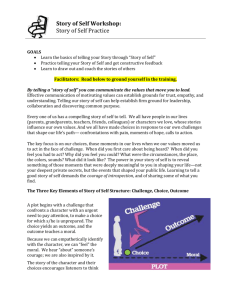Lee et al
advertisement
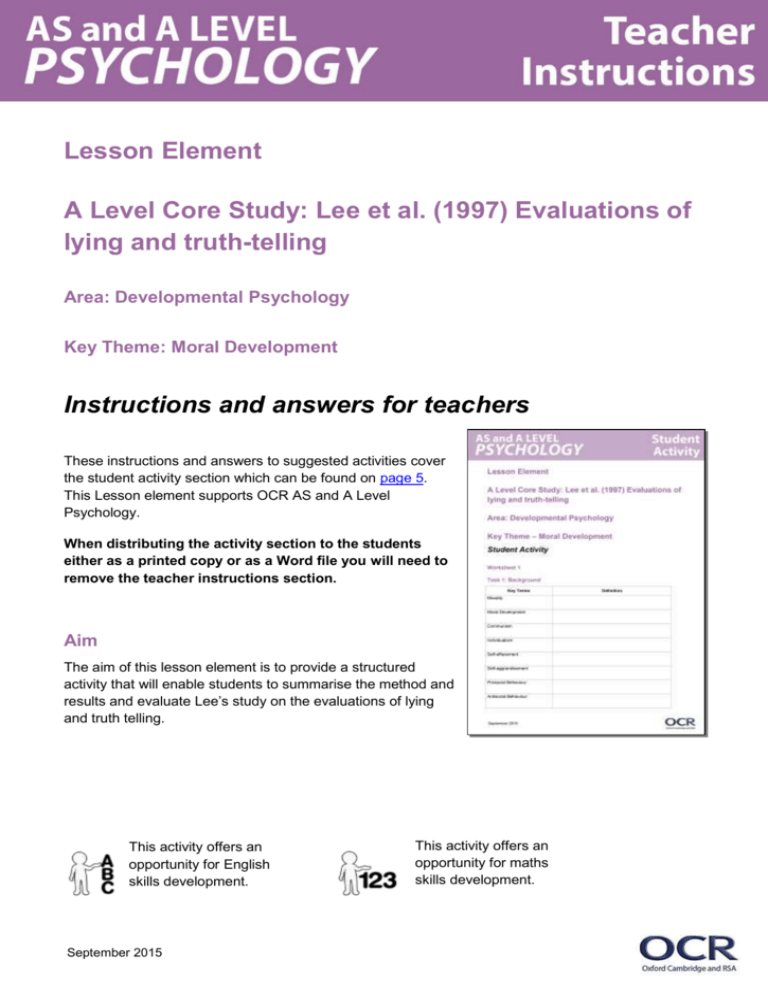
Lesson Element A Level Core Study: Lee et al. (1997) Evaluations of lying and truth-telling Area: Developmental Psychology Key Theme: Moral Development Instructions and answers for teachers These instructions and answers to suggested activities cover the student activity section which can be found on page 5. This Lesson element supports OCR AS and A Level Psychology. When distributing the activity section to the students either as a printed copy or as a Word file you will need to remove the teacher instructions section. Aim The aim of this lesson element is to provide a structured activity that will enable students to summarise the method and results and evaluate Lee’s study on the evaluations of lying and truth telling. This activity offers an opportunity for English skills development. September 2015 This activity offers an opportunity for maths skills development. Objectives To learn key terms to help with the understanding of the study. To identity the sample, why it was used and the sampling technique. Explain the procedure of the study. Summarise results and conclusions from the study. Evaluate methodological issues in relation to the study. Apply the knowledge of the study to ‘moral development’ and the area of ‘developmental psychology’. Explain how Lee’s study pairs with Kohlberg’s. Introduction to the task Background and Summary Because of the difference between Chinese and Western cultures regarding the moral significant of lying and truth telling in good-deed and misdeed situations, Lee was interested in comparing Chinese and Canadian children’s moral judgement. Lee examined the extent to which cultural practices affect the development of children’s understanding and moral evaluations of lying. Chinese and Canadian children were presented with four brief stories that depicted situations that were familiar to both cultures. Two stories involved a child carrying out a good deed and two stories involved a child carrying out a bad deed. When the story characters were questioned by a teacher as to who had committed the deed, they either lied or told the truth. Child participants were then asked to evaluate the story characters’ deeds and verbal statements. Task Instructions A copy of all five worksheets should be printed for each student. For reference, the teacher should have access to information on the study when students are completing these activities. Task 1: Background – Worksheet 1 In order to develop a sound understanding of Lee’s study, it is important to identify key terms associated with the research. Some of these key terms will link with Kohlberg’s study, so could be used as a starter activity to recap prior knowledge of terms such as ‘moral development’. Students could research any key terms themselves which could be done individually or in pairs. This worksheet also has space for learners to write down the ideologies of the Western Worlds in comparison to China, for example China is a communist society that cherishes communitarianism and promotes personal sacrifice for the social good. Schools promote honesty and modesty into their curriculums. Children are encouraged to promote misdeeds committed by themselves or others. They’re also told not to brag about personal achievements and minimise their own good behaviour and grades. In contrast, in the Western world ‘white lies’ and deceptions to avoid embarrassment or hurt are tolerated. Self-aggrandisement is not considered a character flaw as it is in Chinese culture. September 2015 For this task, students could use the original article (pages 925-926) and make notes on the different ideologies which can later be discussed as a class. Alternatively, OCR’s Guide to Core Studies 2 (pages 35-40) on the OCR website or a textbook could be used. Task 2: Procedure – Worksheet 2 To aid students’ understanding of the procedure used by Lee et al, this task requires them to fill in the gaps and annotate the rating scale used in the study. This task could be assisted by either formal teaching, use of the original article, core studies guide, or textbook. Answers to the fill in the gaps activity on this worksheet are provided below. Task: Fill in the gaps - answers Children were tested individually and were first told about the meaning and symbols on a 7-point rating chart. The children then read either four physical stories or four social stories. After each story, children were asked, is what the child did good or naughty? They then had to rate either verbally or non-verbally, their response on a rating chart (below) As a control, the meaning of each symbol was repeated every time the question was asked. Children were then asked the second section of the story and asked, was what the child did good or naughty? The child answered again. Another control was that the words good or naughty were alternated within subjects. To control for order effects, the stories were presented in random orders for each participant. Task 3: Independent variables and understanding the design – Worksheet 3 To aid learners’ understanding of the design/procedure of Lee’s study, this worksheet lays out the structure of the study. For this task, students can fill in the participant numbers for the relevant boxes. Learners can also label the design of each condition and the research method (lab, field/quasi). Alternatively, teachers could give the worksheet to students without any text and learners have to complete the textboxes themselves using the original article, core studies guide, or a textbook. Task 4: Social and physical stories – Worksheet 4 After re-capping learners’ knowledge of the key terms of pro-social and anti-social (which should be covered for worksheet 1), learners need to read the stories taken from Lee’s study and they have to identify whether the story is a physical or a social story. In addition, they need to identify if the story is either a pro-social truth telling story, a pro-social lie telling story, an anti-social truth telling story of an anti-social lie telling story, September 2015 This task will help learners gain an understanding of the task that participants completed. It is important to tell learners that the participants did not read all of the stories. They read either social stories or physical stories. Task 5: Results and Conclusion – Worksheet 5 Students can summarise the results and conclusions from the study in this task. Learners can either use the original article, core studies guide or a textbook to complete this worksheet. Clear differences between the two cultures must be identified i.e. Chinese children generally rated truth telling in pro-social situations less positively than Canadian children. Clear similarities must also be identified. Task 6: Methodological issues – Worksheet 6 The final worksheet can be used to evaluate key issues that can be associated with the study. In addition, learners need to address how Lee’s study can be applied to the understanding of ‘moral development’, how it applies to developmental Psychology, a similarity and difference between Lee and Kohlberg’s study and identifying how Lee pairs with Kohlberg’s study. We’d like to know your view on the resources we produce. By clicking on ‘Like’ or ‘Dislike’ you can help us to ensure that our resources work for you. When the email template pops up please add additional comments if you wish and then just click ‘Send’. Thank you. If you do not currently offer this OCR qualification but would like to do so, please complete the Expression of Interest Form which can be found here: www.ocr.org.uk/expression-of-interest OCR Resources: the small print OCR’s resources are provided to support the teaching of OCR specifications, but in no way constitute an endorsed teaching method that is required by the Board, and the decision to use them lies with the individual teacher. Whilst every effort is made to ensure the accuracy of the content, OCR cannot be held responsible for any errors or omissions within these resources. © OCR 2015 - This resource may be freely copied and distributed, as long as the OCR logo and this message remain intact and OCR is acknowledged as the originator of this work. OCR acknowledges the use of the following content: Maths and English icons: Air0ne/Shutterstock.com Please get in touch if you want to discuss the accessibility of resources we offer to support delivery of our qualifications: resources.feedback@ocr.org.uk September 2015 Lesson Element A Level Core Study: Lee et al. (1997) Evaluations of lying and truth-telling Area: Developmental Psychology Key Theme: Moral Development Worksheet 1 Task 1: Background Key Terms Morality Moral Development Communism Individualism Self-effacement Self-aggrandisement Prosocial Behaviour Antisocial Behaviour September 2015 Definition The Ideology of the People’s Republic of China (PRC) The Ideology of the Western World September 2015 Worksheet 2 Task 2: Procedure 1. Fill in the gaps Children were tested __________ and were first told about the meaning and symbols on a 7-point rating chart. The children then read either four ___________ stories or four _____________ stories. After each story, children were asked, _________________________________________________________.They then had to rate either verbally or non-verbally, their response on a ____________chart (below) As a ___________, the meaning of each symbol was ___________ every time the question was asked. Children were then asked the second section of the story and asked, was what the child did good or naughty? The child answered again. Another ___________ was that the words good or naughty were alternated within subjects. To control for ____________, the stories were presented in __________ orders for each participant. 2. Operationalise/annotate the scale that was used to ask children about whether the character’s behaviour was good/naughty. Very Very Naughty September 2015 Very Naughty Naughty Neither Good or Naughty Good Very Good Very Very Good Worksheet 3 Task 3: Independent Variables and Understanding the Design Canadian Children Total no. of participants: Age 7 No: Age 9 Or Age 11 Age 7 No: No: Or No: Chinese Children Total no. of participants: Or Age 9 Or Age 11 Or No: No Physical Story Social Story Physical Story Social Story Prosocial Behaviour Truth Telling stories Prosocial Behaviour Lie Telling Stories. Antisocial Behaviour Truth Telling Stories. Antisocial Behaviour Lie Telling Stories. September 2015 Or Prosocial Behaviour Truth Telling stories. Prosocial Behaviour Lie Telling Stories. Antisocial Behaviour Truth Telling Stories. Antisocial Behaviour Lie Telling Stories. Prosocial Behaviour Truth Telling stories. Prosocial Behaviour Lie Telling Stories. Antisocial Behaviour Truth Telling Stories. Antisocial Behaviour Lie Telling Stories. Or Prosocial Behaviour Truth Telling stories. Prosocial Behaviour Lie Telling Stories. Antisocial Behaviour Truth Telling Stories. Antisocial Behaviour Lie Telling Stories. Worksheet 4 Task 4: Social and physical stories Below are the stories that the children were given in Lee’s study. Each child only read four out of the eight stories. They either read the ‘social’ or ‘physical’ stories. For each story: 1. Identify whether you think it is a ‘physical’ or ‘social’ story. 2. Identify whether the story is a: o ‘Pro-social behaviour truth telling story’ o ‘Pro-social behaviour lie telling story’ o ‘Anti-social behaviour truth telling story’ o ‘Anti-social behaviour lie telling story’. When Jenny was out at recess, she saw that the school yard was littered with garbage. She picked up all the pieces she could find and threw them in the litter bin. Question 1: Is what Jenny did good or naughty? So Jenny cleaned the school yard and at the end of recess, the teacher said to her students, “I notice that the school yard is now nice and clean!” The teacher then asked Jenny, “Do you know who cleaned the yard?” Jenny said to her teacher, “I did it”. Question 2: Is what Jenny said to her teacher good or naughty? Physical Story Prosocial Truth Telling Prosocial Lie Telling Social Story Antisocial Truth Telling Antisocial Lie Telling September 2015 Ryan wanted to make paper airplanes so he tore some page out of a storybook from the library. Question 1: Is what Ryan did good or naughty? When the teacher noticed the missing pages in the book, she said to the class, “I see that someone has torn some pages from this book.” The teacher then asked Ryan, “Do you know who tore out the pages?” Ryan said, “I did it.” Question 2: Is what Ryan said to his teacher good or naughty? Physical Story Prosocial Truth Telling Prosocial Lie Telling Social Story Antisocial Truth Telling Antisocial Lie Telling Shelly wanted to draw some pictures so took one of the story books from the library and scribbled all over the pages. Question 1: Is what Shelly did good or naughty? When the teacher noticed the scribbled pages, she said to the class, “I see that someone has scribbled all over the pages in this book.” The teacher then asked Shelly, “Do you know who scribbled on the pages?” Shelly said to her teacher, “I did not do it”. Question 2: Is what Shelly said to her teacher good or naughty? Physical Story Prosocial Truth Telling Prosocial Lie Telling Social Story Antisocial Truth Telling Antisocial Lie Telling September 2015 Kelly knew that her friend Anne had lost her money for the class trip and now could not go with the rest of her class. When Anne hung up her coat, Kelly secretly put some money in Anne’s pocket so Anne could go. Question 1: Is what Kelly did good or naughty? When Anne found the money and told her teacher, the teacher said to the class, “Anne just told me that someone has given her money so she can go on the trip”. The teacher asked who left the money for Anne and Kelly said, “I did not do it”. Question 2: Is what Kelly said to her teacher good or naughty? Physical Story Prosocial Truth Telling Prosocial Lie Telling Social Story Antisocial Truth Telling Antisocial Lie Telling Alex’s class had to stay inside at recess time because of bad weather. So Alex decided to tidy up the classroom for his teacher. Question 1: Is what Alex did good or naughty? When the teacher returned after recess, she said to her students, “oh, I see that someone has cleaned the classroom for me.” The teacher asked Alex, “Do you know who cleaned the classroom?” Alex said to the teacher, “I did not do it”. Question 2: Is what Alex said to his teacher good or naughty? Physical Story Prosocial Truth Telling Prosocial Lie Telling Social Story Antisocial Truth Telling Antisocial Lie Telling September 2015 Katie wanted to play with the skipping rope during gym class but discovered that one of her class mates, Sherry, was already playing with it. Katie told Sherry that she wanted the skipping rope and when Sherry said no, Katie pushed her to the ground and made her cry. Question 1: Is what Katie did good or naughty? When the teacher came over to see if Sherry was alright, she said, “oh dear, Sherry has been hurt.” The teacher then asked Katie, “Do you know who just hurt Sherry?” Katie said, “I did it”. Question 2: Is what Katie said to her teacher good or naughty? Physical Story Prosocial Truth Telling Prosocial Lie Telling Social Story Antisocial Truth Telling Antisocial Lie Telling Mark knew that his friend Timmy had lost his lunch money on the way to school and now had no money to buy his lunch. When Timmy left his desk, Mark secretly put some of his own money in Timmy’s desk so Timmy could buy some lunch. Question 1: Is what Mark did good or naughty? So Mark left some money for Timmy and when Timmy found the money, he told his teacher. The teacher said to the class, “Do you know who left the money for Timmy?” Mark told the teacher that he did it. Question 2: Is what Mark said to his teacher good or naughty? Physical Story Prosocial Truth Telling Prosocial Lie Telling Social Story Antisocial Truth Telling Antisocial Lie Telling September 2015 A boy named Jimmy had just joined Paul’s class and Paul decided that he didn’t like him. Paul went over to Jimmy and when the teacher was not looking, Paul pushed Jimmy to the ground and made him cry. Question 1: Is what Paul did good or naughty? When the teacher came over to see if Jimmy was all right, she said, “Oh dear, Jimmy has been hurt”. The teacher then asked Paul, “Do you know who just hurt Jimmy?” Paul said to his teacher, “I did not do it”. Question 2: Is what Paul said to his teacher good or naughty? Physical Story Prosocial Truth Telling Prosocial Lie Telling Social Story Antisocial Truth Telling Antisocial Lie Telling September 2015 Worksheet 5 Task 5: Results and Conclusions Results Similarities between Canadian and Chinese children: Differences between Canadian and Chinese children: Conclusions September 2015 Worksheet 6 Task 6: Methodological Issues How the study is ethical and why How the study is unethical and why How the study is valid and why How the study is invalid and why How the study is reliable and why How the study is unreliable and why How the study is ethnocentric How the study is crosscultural How the sampling method doesn’t have bias How the sampling method has bias Ethics Definition: Validity Definition: Reliability Definition: Ethnocentrism Definition: Sampling Bias Definition: September 2015 How does the study apply to the key theme of ‘moral development’? How does the study apply to the area of ‘developmental psychology’? What is one similarity and one difference between Kohlberg’s study and Lee’s study? How does the study pair with Kohlberg’s study? September 2015
